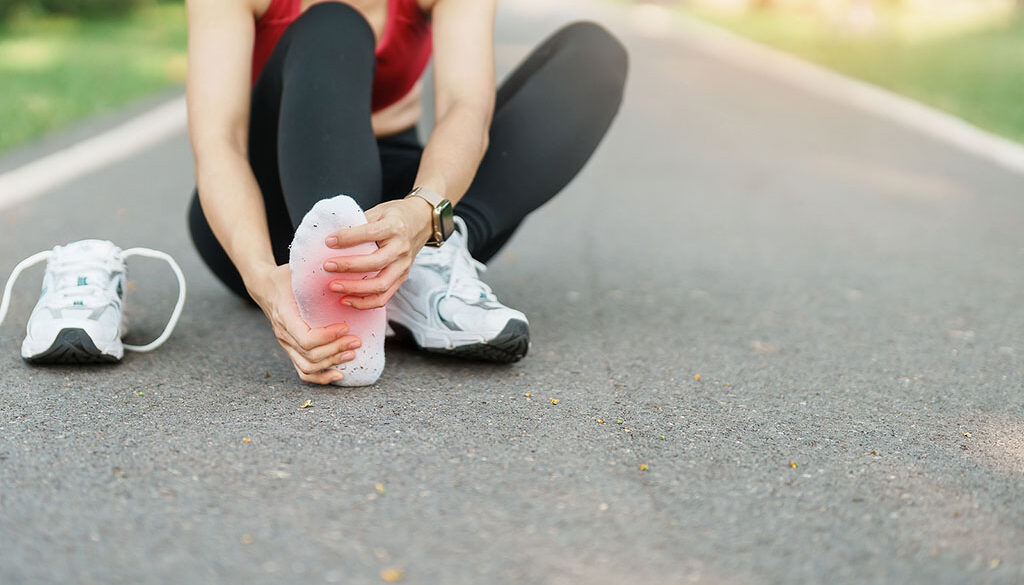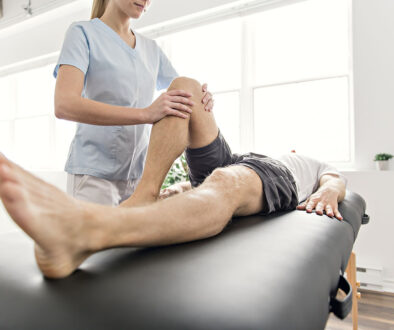Our Foot Doctors Explain Causes of Foot Pain After Running
In this article:
If you’re a regular runner and consistently experience foot pain after running, you’re not alone. Running is a high-impact activity that can put a substantial amount of stress on the feet, so it’s no surprise that this issue commonly affects runners of all levels.
If your foot pain is mild, it may be possible to alleviate it on your own with the right prevention strategies or recovery methods, but if it’s persistent, don’t ignore it – it might be time to have it evaluated by a sports medicine specialist.
At Raleigh Medical Group, our sports medicine specialist is here to not only help you recover from injuries, but to help you be proactive so you can avoid injuries as well. With a focus on comprehensive care, we can get you back in the game as soon as possible, whether that means playing competitive sports or just taking a jog around the block. We invite you to discover our dedication by scheduling an appointment.
In this article, we’ll examine the causes of foot pain after running, consider tips for relieving foot pain, and discuss other ways to recover post-run.
Why Do My Feet Always Hurt After I Run? Causes of Foot Pain After Running
The anatomy of our feet is complex, with 26 bones connected by numerous joints, muscles, tendons and ligaments. Running involves repetitive impact combined with complicated mechanics that can lead to foot pain, especially if:
- Your gait is off
- Your running shoes don’t fit properly
- Your shoes don’t provide appropriate support
Foot pain after running can have several causes, such as fractures, sprains, or nerve damage. Some common causes of foot pain after running include:
Foot Fractures
Foot fractures are breaks in one or more of the 26 bones that make up the foot, due to overuse, sports injuries, falls or other causes. This may result in pain and swelling at the site of the fracture. While some minor fractures can heal on their own with rest and ice, severe fractures may require surgery.
Plantar Fasciitis
Plantar fasciitis is a common condition that causes pain in the heel of the foot due to inflammation of the plantar fascia, the band of thick, fibrous tissue that connects the heel bone to the ball of the foot and helps support the arch.
The condition can be caused by:
- Overuse of the sole or plantar of the foot
- Walking or running with tight calf muscles
- Prolonged walking or standing on hard surfaces
Symptoms may include dull aches or stabbing pains in the heel or arch of the foot.
Pain in the Ball of the Foot
This may be caused by nerve or joint damage on the bottom of the foot behind the toes.
Another condition that can create pain in this area of the foot is a noncancerous growth known as Morton’s neuroma, caused by thickening of the tissue around a nerve, usually between the third and fourth toes in the ball of the foot.
Heel Spurs
These bone growths are on the heel bone where it connects to the plantar fascia.
Sometimes the plantar fascia can become overstretched from running, wearing shoes that don’t fit properly, or being overweight, leading to pain from stress and inflammation of the tissue pulling on the bone.
Heel spurs result from the body building extra bone as a response to chronic irritation or stress on the heel bone.
Flat Feet or High Arches
These can make you more susceptible to foot pain.
In addition to the foot conditions above, other causes of foot pain after running may include:
- Increased running intensity or frequency, which puts stress on your feet
- Overtraining, which can lead to overuse injuries.
- Running on hard surfaces like concrete or asphalt, which increases impact and may lead to pain
- Improper running form, including overpronation (when your foot rolls inward too much), or supination (when your foot rolls outward excessively)
- Running shoes that don’t fit properly, are worn out, or don’t provide enough support
How Can I Fix Foot Pain from Running?
At Raleigh Medical Group, we know that resolving your pain centers around an accurate and timely diagnosis. Therefore, our experts will work closely with you to not only get to the heart of the problem but to develop a personalized care plan to ease your discomfort.
Methods for alleviating foot pain after running will depend on the specific cause of your pain.
Foot Fracture Treatment
Treatment depends on where the fracture is located. Fractures of the metatarsal bones in the middle of the foot may simply need support from a cast, boot, or stiff-soled shoe as the foot heals.
If the small sesamoid bones, located at the end of the metatarsal bone of the big toe are fractured, padded soles may help relieve pain. Toe fractures typically heal with or without a cast.
Some fractures are more serious and may require immediate medical attention, such as ankle joint fractures. If not treated properly, this kind of fracture can lead to more serious complications, including persistent pain or further joint damage.
Seek care at an emergency room or urgent care center if you have an ankle joint fracture.
Plantar Fasciitis Treatment
Treatment may include:
- Rest
- Nonsteroidal anti-inflammatory medications (NSAIDs)
- Applying ice to the affected areas
- Stretching exercises of the Achilles tendon and plantar fascia
- Footwear with good arch support
Treatment for Pain in the Ball of the Foot
Treatment may include rest, ice, supportive shoe inserts or orthotics, and over-the-counter pain relievers. In some cases, corticosteroid injections or surgery may be necessary.
Heel Spur Treatment
Treatment options for heel spurs may include:
- Rest
- Ice packs
- Anti-inflammatory medication like ibuprofen
- Stretching before activity
- Shoe inserts
- Corticosteroid injections
- Surgery may be considered in severe cases
Other methods to help prevent or relieve foot pain from running include:
- Properly fitting, supportive running shoes
- Improvements in your running form
- Adequate rest and recovery between runs
- Stretching exercises for the feet and legs
- A warm-up before running with a few minutes of light cardio
- A cool-down session after running
- Gradual increases in mileage and intensity to allow the body to adjust
It can also help to consult with our sports medicine doctor about proper running form, enhancing performance and preventing injuries.
If your foot pain is persistent or worsening, address the issue with your healthcare provider.
What Recovery Methods Can I Use After Running?
There are several ways to recover post-run by adding these practices:
- Hydrate and replenish with fluids.
- Refuel with a healthy snack or a balanced meal.
- Stretch thoroughly to improve flexibility and range of motion.
- Apply self-massage to tense muscles.
- Cool down with gentle walking or jogging at the end of your run.
- Consider cross-training with:
- Swimming
- Walking
- Yoga
- Low-impact exercises
These add variety to your exercise routine. This can help relieve tightness and soreness from running.
- Rest and recover: Be sure to include at least one rest day in your running regimen.
- Prioritize quality sleep, which helps with muscle repair and recovery (and is imperative for overall health, of course).
Stretches for Foot Pain
Stretches that focus on enhancing flexibility and strength in the arches, calves, and Achilles tendon can help relieve foot pain. Some stretching exercises include:
- Seated foot stretches
- Heel raises
- Calf stretches
- Rolling a tennis ball under your foot
- Towel scrunches, which involve grasping a towel with your toes and pulling it toward you, then releasing
Exercises that specifically help prevent plantar fasciitis involve strengthening your arch muscles, which helps support the plantar fascia. You can do this by using towel scrunches as described above, or by stretching the arches of your foot by grasping your toes and gently pulling them toward you while sitting.
Additionally, you can stand with your back leg straight and heel down with your hands against a wall, then move your hips forward until you feel a stretch in your calf. Hold the stretch for 30 seconds, then switch legs and repeat, being careful not to bounce. Do a couple of repetitions a few times a day.
We can provide additional input and guidance if you need to learn more about how to safely and correctly perform these stretches and related exercises.
Raleigh Medical Group is Your Home for Diagnosis and Treatment of Foot Pain
Running is a great way to get and stay in shape. Unfortunately, if you run often and consistently experience foot pain, your fitness routine will suffer.
While foot pain might not seem that serious initially, it shouldn’t be ignored, as neglecting it can lead to more serious injuries.
If you’ve already tried to alleviate your foot pain with the approaches above and the pain is persistent or worsening, get in touch with us to schedule an appointment. We also have a board-certified sports medicine physician with extensive experience who can treat sports-related injuries and provide non-surgical evaluation of orthopedic or joint issues.
Key Takeaways:
- The foot has complex anatomy, with muscles, tendons and 26 bones.
- There are several causes of foot pain after running, and the most common ones are:
- Fractures
- Plantar fasciitis
- Heel spurs
- Flat feet or high arches
- Treatment depends upon the underlying problem, and may include:
- Stretching exercises
- Staying hydrated
- Medications
- Casts/splints
- Self massage
- Cool down routines
- Cross-training with other activities
- Adequate rest
- Healthy sleep
- In serious cases of foot pain or foot injury, surgery may be needed.
The content within this article and others on this website is only for educational purposes and should not be considered medical advice. For any questions or concerns, please consult with your health care provider.
Sources:
- Hopkins Medicine, “Foot Pain and Problems”
https://www.hopkinsmedicine.org/health/conditions-and-diseases/foot-pain-and-problems - Mayo Clinic, “Foot Stretches to Prevent Plantar Fasciitis,”
https://www.mayoclinic.org/diseases-conditions/plantar-fasciitis/multimedia/foot-stretches-to-prevent-plantar-fasciitis/img-20008230 - Cleveland Clinic, “Perfect Your Running Gait to Avoid Injury,” https://health.clevelandclinic.org/perfect-your-running-gait-to-avoid-injury-improve-your-time




